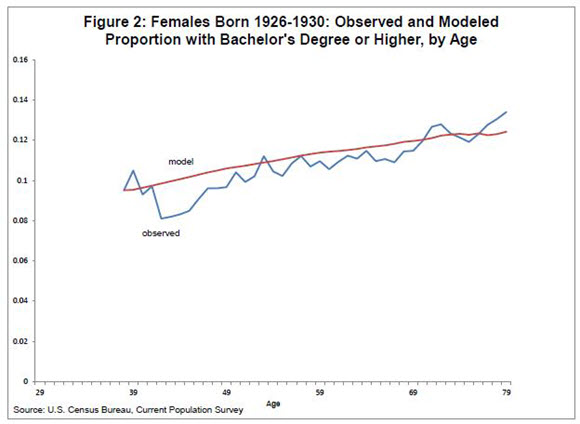Over the Hill at 25? College Completion at Higher Ages
Over the Hill at 25? College Completion at Higher Ages
For many years (since 1942 to be exact) when the U.S. Census Bureau has reported educational attainment, it has focused on the population age 25 and older. The reason for this practice was that, “The statistics made available today relate only to persons 25 years old and over, those who may generally be considered as having completed their formal education.”
Since then, few have questioned this practice and logic, and researchers have remained comfortable with the assumption that “most people get their schooling during their childhood, teens and 20s …”
Thinking about education as being “fixed” through most of adulthood makes things easier for researchers who want to examine trends in education. But in recent years, there have been hints that this traditional assumption is breaking down. To look more closely, I took advantage of the large collection of data from the Current Population Survey from 1967 to 2015. I was able to follow age groups across a large portion of their lives to see how education patterns evolved as they got older.
Figure 1 shows trends in the percentage of women who had a bachelor’s degree or higher for several birth cohorts (women who were born in the same group of years). Those born around 1935 are at the bottom, having lower education than women who were born later in the century. When the group was in their early 30s (around 1968), 9 percent of the group had a bachelor’s degree or higher. By 2010, when the group was around 75, 17 percent had a bachelor’s degree or higher.
A similar pattern can be observed for younger groups of women (born in later years). They have increasingly higher levels of college completion at age 25 and continue to gain as they move from 25 to older ages. As for men, the story is pretty much the same, although shifts from one cohort to the next are not as smooth as they are for women (not shown).
What can we make of the pattern of growth in college completion that takes place across the lives of a group of people? Are we seeing the result of lots of people who delayed college graduation until later in life? Are other forces at work?
Besides graduation, there are at least two other things that could be happening. First, immigration could be contributing to college growth at later ages. While many immigrants have low levels of education, there is a large subset of immigrants to the United States with bachelor’s and higher degrees.
Another factor affecting the proportion of a cohort having a bachelor’s degree is mortality. Research has strongly established a relationship between education and mortality such that people with bachelor’s degrees survive to greater ages, and thus make up a greater part of the cohort as it gets older.
With the Current Population Survey data, I was able to measure the level of education, the rate of graduation and the effect of immigration for a set of cohorts of men and women such as those shown in Figure 1. In order to measure mortality, I made use of a dataset produced by the Census Bureau called the National Longitudinal Mortality Study. Using demographic life-table methods, I calculated what we might expect for each of these cohorts given the forces we could measure. The question was: Would I be able to come close to the observed patterns using just these factors?
Figure 2 shows the observed level of college completion for women who were born from 1926 to 1930, which moves in a slightly jagged pattern from 9 percent at age 38 (the youngest age for which I have data) to 12 percent at age 75. The “model” line is set up to start at the same point, 9 percent at age 38. From there, I allow graduation, immigration and mortality to change the percentage of the cohort with a college education, with no constraints. As it turns out, however, the model line runs along a very similar path to that which is observed from people reporting their levels of education. Both lines show 12 percent of the cohort having a bachelor’s degree at age 75.
When I looked at other cohorts of men and women born from 1926 to 1970, I obtained similar results. Although I was unable to conduct statistical tests because of the complexity of some of the calculations, the end result is satisfying. What appears at first to be a strange pattern of college attainment growing throughout the lifespan is indeed the plausible result of basic demographic factors at work. That is, the growth of education in this country continues across the lifespan because of the willingness of Americans to continue their education in adulthood and because of the contribution of immigrants who come to this country with higher degrees. A reward of higher education is greater longevity, which results in a greater share of college-educated people at higher ages. Taken together, these forces have had an important influence on the growth of education in the past century.
Check out my paper:





